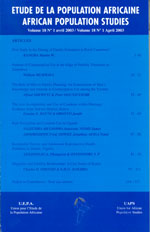
|
African Population Studies
Union for African Population Studies
ISSN: 0850-5780
Vol. 28, No. 2s, 2014, pp. 917-926
|
 Bioline Code: ep14037
Bioline Code: ep14037
Full paper language: English
Document type: Research Article
Document available free of charge
|
|
|
African Population Studies, Vol. 28, No. 2s, 2014, pp. 917-926
| fr |
Robinson, Rachel Sullivan; Meier, Ann; Trinitapoli, Jenny & Svec, Joseph
Résumé
Nous montrons d'abord comment les Enquêtes Démographiques et de Santé (EDS) peuvent être intégrés
avec des autres sources de données pour créer des nouveaux types de variables pour l'analyse de la population
et de la santé. Deuxièmement, nous modélisons les déterminants des résultats pour la santé de
l'environnement social, physique, et construit au niveau du district au Ghana, au Malawi et en Tanzanie. Pour
faire cela, nous avons utilisé l’EDS pour créer des mesures au niveau dudistrict, et les avons fusionnés avec les
données de l'IPUMS, de TerraPopulus (que s’agit de l’environnement), et des autres sources. Il est possible de
combiner l’EDS avec les autres sources des données, et les indicateurs de santé et d'environnement sont
hétérogènes au sein des pays. Cela justifie une analyse plus approfondie aux échelles géographiques plus
locales et indique les avantages d’utiliser ces techniques pour concevoir des interventions programmatiques
localisé.
Mots Clés
EDS; IPUMS; TerraPopulous; Analyse Spatiale; Santé
|
| |
| en |
Integrating the Demographic and Health Surveys, IPUMS-I, and TerraPopulus to Explore Mortality and Health Outcomes at the District Level in Ghana, Malawi, and Tanzania
Robinson, Rachel Sullivan; Meier, Ann; Trinitapoli, Jenny & Svec, Joseph
Abstract
In this paper, we first show how the Demographic and Health Surveys (DHS) can be integrated with other data sources to expand the types of variables available for analysis of population and health outcomes. Second, we demonstrate one particular example of such integration by modelling the social, physical, and built environment determinants of health outcomes at the district level in Ghana, Malawi, and Tanzania. To do so, we created district-level measures of a number of variables from the DHS, and then merged them with district-level data from the IPUMS, an environmental data set called TerraPopulus, and other sources. We find that it is feasible to combine the DHS with other data sources, and that many health and environment indicators are heterogeneous within countries, justifying further analysis at low levels of geography and suggesting benefits to using such techniques to design fine-grained programmatic interventions.
Keywords
DHS; IPUMS; TerraPopulous; Spatial Analysis; Health
|
| |
© Copyright 2014 - African Population Studies
Alternative site location: http://www.uaps-uepa.org
|
|
